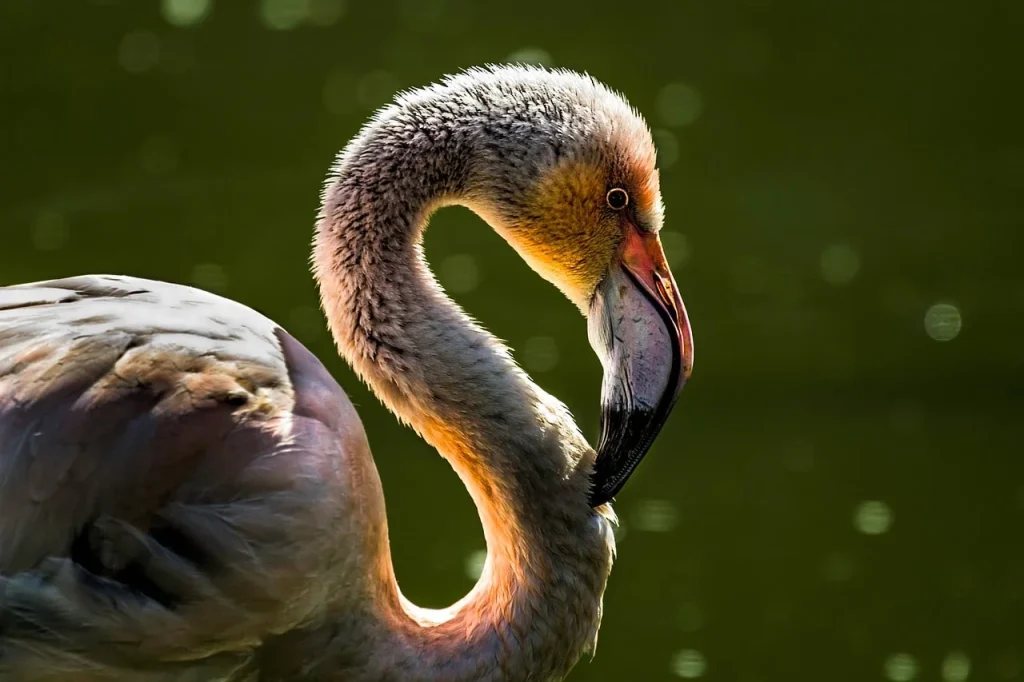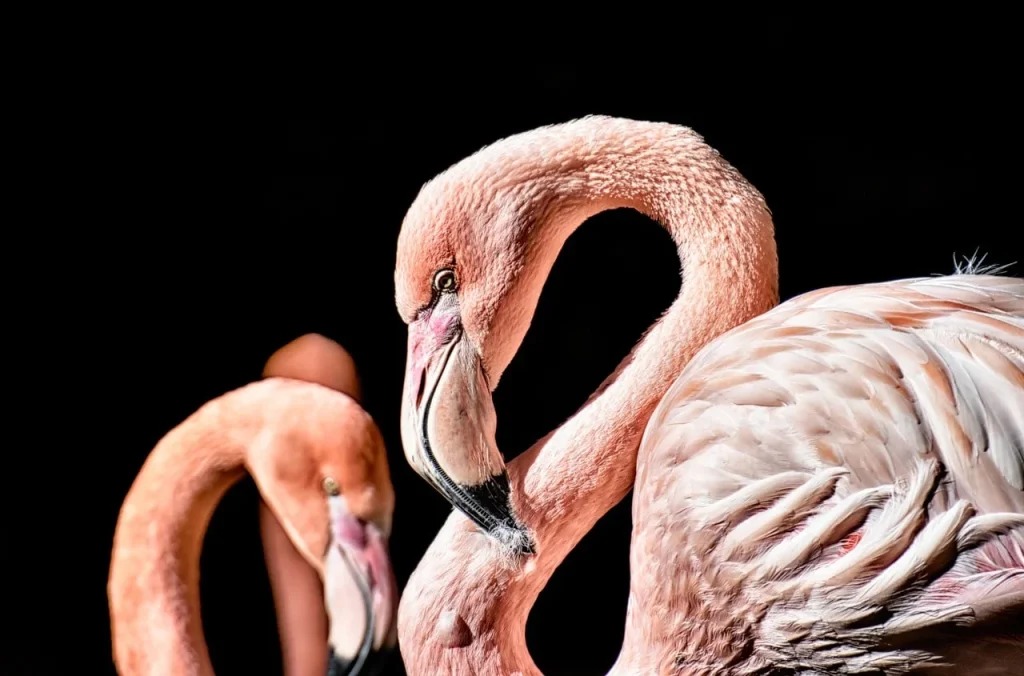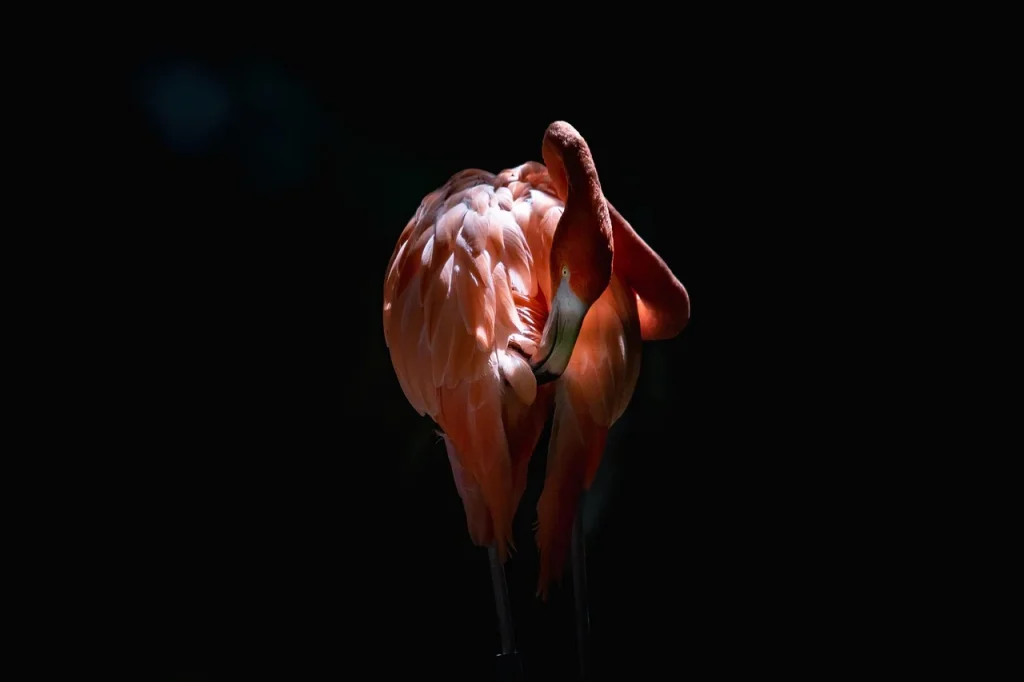Welcome to the colorful and curious world of flamingos! These birds are famous for their bright pink feathers, but there’s so much more to them than just their looks.
Today, we’re exploring some fascinating facts about flamingos. You’ll find out how they get their pink color, why they can drink boiling hot water, and many other secrets about their unique lives. Get ready to be amazed by the hidden world of these iconic birds.
Flamingos are not born pink; they become beautiful.
Zoe Saldaña
Flamingos Facts
Get ready to explore the facts! Make sure you absorb all the information, as I prepared a quiz at the end to challenge your flamingo knowledge.
- Their pink hue comes from the carotenoids in their diet, primarily obtained from algae and crustaceans.
- They can drink boiling hot water from geothermal springs when other water sources are frozen.
- Their nests are made from mud and are about 12-24 inches in diameter and have a slight depression in the center to hold eggs.
- These birds are monogamous, sticking with one partner for several breeding seasons, and sometimes for life.
- The kidneys of these birds are highly efficient, extracting fresh water from seawater while excreting salt through glands in the nostrils.
- Their backward bending knee is actually an ankle; the actual knees are hidden under body feathers.
- They produce a milk-like substance from their digestive tract to feed chicks, a trait shared with pigeons and male emperor penguins.
- Their vibrant coloration can fade with age, diet changes, or during periods of malnutrition.
- In the wild, their lifespan averages 20-30 years, but in captivity, they can live up to 50 years.
- Chicks are born with gray and white plumage which turns pink gradually over 1-3 years.
- A group of these birds can be called a “pat,” “colony,” flamboyance, or stand.
- Their eyes are larger than their brain, providing excellent visual perception for spotting food in murky water.
- Their bills are uniquely designed to filter food from silt and mud while their head is upside down.

- The ancient Romans considered their tongues a delicacy.
- Flight speed can reach up to 35 miles per hour, and they are capable of traveling hundreds of miles in one flight.
- Four flamingo species are found in the Americas and two species are native to Africa, Asia, and Europe.
- Their social structure is complex, often forming large flocks to provide safety in numbers from predators.
- Isolation can cause them stress and health issues, emphasizing their need for social interaction.
- They use both vocalizations and body language to communicate, including honking, growling, and wing flapping.
- Their feet have webbing between three toes that helps in stirring up mud, making it easier to find food.
- Chicks begin to vocalize even before hatching, and parents can recognize their call.
- Their coloration can act as a deterrent to algae growth on their feathers, keeping them clean while wading through stagnant waters.
- During mating displays, they perform synchronized movements, which can include head flagging, wing salutes, and marching.
- Flight requires a running takeoff to gain enough lift due to their long legs and large wing span.
- Satellite tagging has revealed that some can travel over 300 miles in one night during migratory flights.
- They’re capable of resting half their brain while keeping the other half alert, a phenomenon known as unihemispheric slow-wave sleep.
- Paleontological evidence suggests that their ancestors date back at least 30 million years.
- Their beaks are not only specialized for filtering but are also highly adjustable to capture different sizes of food particles.

- In zoos, their color is maintained through supplemented diets that include prawns, shrimp, and specialized pellets with canthaxanthin.
- They have been observed using their feet to pat down their nests to strengthen them against potential flood damage.
- Despite being able to fly, they are excellent swimmers, often seen paddling in deep water.
- Their ability to store air in their body helps them maintain buoyancy and thermal regulation in cold waters.
- A single large egg is laid per breeding cycle, which both parents incubate by balancing it on their feet under their body feathers.
- In ancient Egypt, they were symbolic of the sun god Ra, representing the vibrant colors of the sunset.
- Environmental changes, particularly in salinity and wetland drainage, are significant threats to their habitats.
- Some cultures believe that eating their meat can cure diseases or impart vigor and health.
- Research has shown that the color pink can influence mating success and social standing within the flock.
- They are known to engage in allopreening, a social behavior where individuals clean each other’s feathers.

- Their population statuses vary widely, with some species considered near threatened due to habitat loss and environmental disruptions.
- Facial discoloration can occur due to different types of algae consumed in varying habitats.
- They prefer to feed in salty environments that often host a few other bird species, reducing competition.
- Their feces can contribute significantly to the nutrient cycle of their ecosystems, supporting a variety of aquatic life.
- Genetic studies have suggested that there are subtle differences between populations that are not immediately visible through physical traits.
- Fossil records indicate that ancient species could be found as far north as what is now the Canadian Arctic.
- Their legs are covered in a special grease that is secreted by glands located near their tail, helping to repel water and prevent heat loss.
- In captivity, they sometimes require specially designed shallow pools to mimic their natural foraging grounds.
- Occasionally, individuals exhibit unusual behaviors such as dancing or playing with objects, suggesting a level of curiosity and playfulness.
- Their respiratory system is highly efficient, allowing for extended periods of activity without fatigue, which is important during long migrations.
- Conservation efforts in some regions have successfully increased their numbers by improving habitat conditions and legal protections.
- Their unique skeletal structure includes a collapsible rib cage that allows them to compress their body during flight, making them more aerodynamic.
Flamingos Myths

Now that we’ve explored the facts, let’s continue with the myths. We’re going to separate what’s true from what’s just folklore.
- Flamingos Are Naturally Pink
It is often believed that they are born with pink feathers. However, the distinctive pink color is not innate but is developed over time. The diet of flamingos, which is rich in carotenoid pigments found in algae and crustaceans, is responsible for the pink and red hues of their feathers. - Flamingos Can Only Be Found in Warm Climates
While many associate flamingos with warm tropical locations, they are not exclusive to these areas. Species such as the Andean flamingo are well-adapted to the cold environments of the Andean mountains, where temperatures can be harsh. - Flamingos Drink Fresh Water Only
It is commonly assumed that they require fresh water for drinking. In reality, these birds are often found in highly saline or alkaline lakes. Special glands located in their nostrils, which filter out salt, are used by them to manage these challenging conditions. - Flamingos Eat by Pecking at the Water Surface
Contrary to the belief that flamingos feed by pecking at the water’s surface, they actually use a unique filter-feeding mechanism. Their beaks are used upside down in the water, where suction is created to draw in food along with water. - Flamingos Are Social Birds Year-Round
While they are indeed social birds, often seen in large flocks, this is not the case throughout the entire year. Outside of the breeding season, it is common for these flocks to disperse, and flamingos are found to be more solitary or in smaller groups.
No products found.
Flamingos Quotes

We continue with some flamingo quotes. These are my favorites, but you are welcome to share yours in the comments so I can add them to the list.
In a world full of pigeons, be a flamingo.
Chris D’Lacey
Chris D’Lacey uses this metaphor to encourage individuality and standing out, much like the distinctive presence of a flamingo among birds.
The flamingo stands out in any crowd with its grace and vibrancy.
Isabella Rossellini
Isabella Rossellini admires the flamingo for its elegant and vibrant appearance, emphasizing its unique appeal.
Flamingos are the embodiment of balance and beauty in nature.
David Attenborough
David Attenborough appreciates flamingos as a symbol of natural equilibrium and aesthetics, praising their poised and picturesque form.
To understand a flamingo, one must appreciate its ability to thrive in chaos.
Annie Leibovitz
Annie Leibovitz comments on the resilience and adaptability of flamingos, capable of flourishing even in challenging environments.
Seeing a flamingo fly is like watching a painting take flight.
Sir Elton John
Sir Elton John beautifully captures the majestic and artistic quality of a flamingo in flight, likening it to a moving piece of art.
Flamingos FAQ

Before you test your knowledge with the quiz, let’s first read the FAQs. Read carefully if you want to score a perfect ten.
- Can flamingos swim?
Yes, they can swim. Although they are more often seen wading in shallow waters, their webbed feet make them quite capable swimmers when they need to navigate deeper waters. - Are flamingos native to Florida?
They are not originally native to Florida, but they are often seen there. Historically considered visitors, recent studies suggest that Florida may have been part of their native range before populations declined due to human activity. - Can flamingos fly?
Absolutely! They are strong fliers. They can travel hundreds of miles to find suitable habitats or food sources. You might see them flying in large groups in a V-formation, which is quite a sight! - Are flamingos an endangered species?
Flamingos as a whole are not endangered, but their populations can be vulnerable or threatened due to habitat loss and other environmental pressures. Conservation efforts are crucial to maintaining their numbers in the wild. - Can flamingos be blue?
They cannot be blue; their color ranges from light pink to bright red, depending on their diet. The pigments in their food (like carotenoids from algae and crustaceans) dictate their coloration. Blue would be an unnatural color for them.
No products found.
Flamingos Trivia

Welcome to our fabulous flamingo quiz! Just remember, if you don’t get any questions right, a flamingo might just steal your lawn decor as punishment!
Conclusion
Finally, our journey through the lives of flamingos shows just how mesmerizing these creatures are. With habits and features that seem almost otherworldly, flamingos are a testament to the adaptability and beauty of wildlife.
As we protect and cherish them, we also gain insights into the balance of ecosystems. They not only beautify our world but also play crucial roles in their habitats. Till next time, stay curious and explore more. Cheers.


